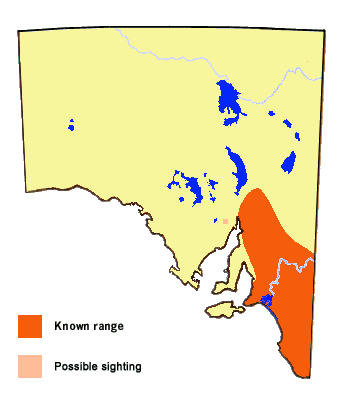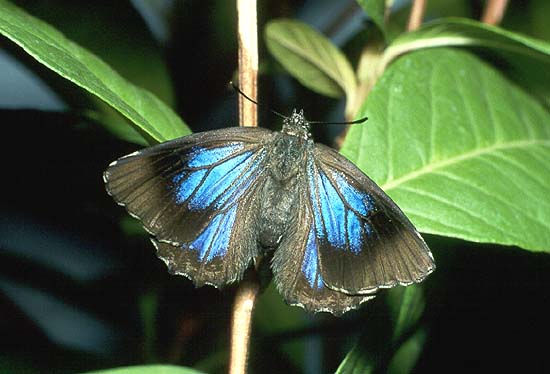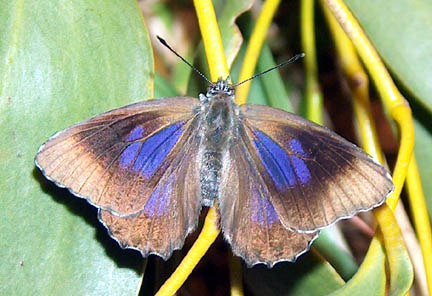-
Larval Food Host
-
The mistletoes Amyema miquelii (box mistletoe) and
A. pendula pendula (drooping mistletoe) (Loranthaceae).
The larvae eat the flower buds, flowers, leaves and soft stem parts of the mistletoe,
but are particularly fond of the flower buds. The mistletoes usually associate with
Eucalyptus, although A. pendula will also parasitise Acacia melanoxylon,
particularly in the Lower Southeast Region of the state.
-
Larval Attendant Ant
-
Larvae are attended by a few ants including
a small black Anonychomyrma sp,
a small Crematogaster sp,
small dark brown, black or orange and black Iridomyrmex spp,
a small black Ochetellus sp,
Podomyrma adelaidae a brown ant with two yellow spots on the abdomen,
the sugar-ants Camponotus consobrinus
and C. terebrans,
and rarely Papyrius sp (nitidus group).
The presence of the conspicuous Podomyrma adelaidae on a eucalypt
harbouring the mistletoe host is usually a sure sign that the butterfly is also present
in the area. In the eastern states, early stages are also known to be attended by
Froggattella kirbii and Monomorium sp.
-
Eggs
-
Small, dark grey to black, hemispherical shape, basally flattened, the top is domed.
The sides are coarsely reticulated in a hexagonal pattern that continues to the small
pale coloured, depressed micropylar area at the apex of the egg. At each reticulation
intersection there is a small raised blunt projection. The egg is typical of the eggs
for the O. olane Species Subgroup. They are usually laid singly, on the leaves,
stems and bole of the hostplant, and sometimes on the adjacent host plant.
-
Larvae
-
The first instar is pale greyish yellow, later becoming pale brown after eating the young
leaves of the hostplant. Long onisciform shape, with scalloped lateral edges. The posterior
dorso-lateral organs are not developed. The head is large, smooth, brownish yellow, hidden
beneath the body. There are long dark peripheral and dorsal setae, which are longest anteriorly,
posteriorly and dorsally. Dorsal setae occur in two pairs, one pair being long and recurved,
the other pair being short, recumbent and directed to the rear. Intermediate instars gradually
lose the long dorsal setae and gain the posterior dorso-lateral organs, and are onisciform
(slater shaped). They are usually brown coloured.
First instar larvae remain exposed on the leaves of the mistletoe. Subsequent instars hide
during the day, and feed at night. They shelter during the day beneath bark at the base of
the mistletoe or on the adjacent host tree, or in crevices in the mistletoe host, or in
borer holes or ant tunnels in the mistletoe or mistletoe host, but always as near as
possible to the mistletoe. If there is no bark near the mistletoe, then they will shelter
beneath the nearest available bark below the mistletoe on the host tree. The young larvae
initially eat the young tips of the mistletoe, but quickly graduate to older leaves and
flower buds. There are usually only two or three larvae present on a mistletoe that is
actually being utilised by the butterflies, but sometimes they can be more prolific.
Larvae will aggregate together if the shelter is large enough.
The fifth (final) instar is about 20-24 mm long, usually dark purplish brown coloured,
but those from the Southeast Region can be yellowish dark brown, there are pale yellow
dorsal chevron markings and other indistinct subdorsal markings, the chevrons on abdominal
segment 6 are usually joined together to form a yellow triangular mark, the anterior and
posterior extremities are usually free of pale markings, the prothoracic and anal plates
are greyish, and the spiracles are yellow rimmed black. Onisciform shaped with a thoracic
dorsal furrow, the lateral edges are scalloped, and the anterior and posterior areas are
flattened, and there are some short peripheral hairs that are longer anteriorly and
posteriorly. The body is covered in pale and dark coloured, minute secondary setae, which
are recumbent, club shaped and rough in appearance, set on a protuberant,angular and ridged
base. The secondary setae impart a scabrous appearance to the larvae. The posterior
dorso-lateral organs are well developed. The head is small, smooth, brown, hidden beneath
the body. Near pupation the larvae acquire an emerald green tinge.
Larvae normally take five instars to fully develop, but sometimes they will take more although
this is usually indicative of the larvae having physiological problems, due probably to
agricultural chemicals affecting the environment.
Larvae will sometimes cohabit with larvae of O. genoveva in the galleries of the large
Camponotus ants that have been made for the larvae of O. genoveva. There they
will behave as if they were O. genoveva larvae.
-
Pupae
-
Short cylindrical, rounded anteriorly and posteriorly, about 13-16 mm long, brown to
dark brown coloured, with a darker dorsal line and other darker cryptic markings,
although the dorsal thoracic and anterior dorsal abdominal areas are noticeably paler.
There is usually a pair of large, dark brownish black dorsal spots above the head.
The surface of the pupa is without hairs, but bears a very fine reticulated pattern
(similar to the eggs) that produces a very fine scabrous surface, and which includes
tiny specialised secondary setae that are more common around the spiracles. The pupal
period is variable, depending on the time of year, being about 25-32 days in spring,
12-18 days in summer and early autumn, and about 29 days in late autumn.
Pupation normally occurs well away from the mistletoe near the base of the host tree
(usually Eucalyptus), within a metre of the ground, but sometimes larvae will
pupate in the final larva shelter near the mistletoe. Larvae usually pupate singly,
but occasionally if there is a large enough population they will pupate gregariously
near each other or next to an empty pupa shell. Pupating larvae will sometimes surround
themselves with a loosely webbed, silken cocoon-like shelter, which presumably helps
hold the loose bark onto the host tree, or affords some protection from larger predators,
or perhaps from other Ogyris larvae which can cannibalise soft pupating larvae.
There is normally space within the silk webbing for the small attendant ants to pass
through to attend to the live pupae. Pupae are attached to the silked substrate by anal
hooks and a central girdle.
Like many Lycaenidae that are attended by ants, but particularly many of the Ogyris,
the butterflies emerge with the body covered in large quantities of fluffy grey 'down',
which is discarded when the butterfly first flies. This down helps protect the butterfly
from being attacked by over-zealous attendant ants, or even other small predators, while
the butterfly is expanding and hardening its wings in readiness for first flight.
The pupae are known to stridulate, making a series of audible clicks, which are believed
used as a means of communicating with the attendant ants. There is usually at least one
ant in attendance with a pupa.
-
Flight Period in South Australia
-
The butterfly flies throughout the warmer months, but with the greatest activity during
the flowering of its mistletoe hostplants, which are used for nectaring purposes by the
adults. The flight starts earlier in the northern areas. Most of the activity finishes
by early autumn, but there are odd records into early June. A summer brood can be completed
in about 11 weeks. Larvae can go into a torpid (semi-hibernation) state over winter.

-
Distribution
-
In South Australia the butterfly usually exists wherever its mistletoe hostplants occur
in habitat having annual rainfall in excess of about 300 mm. There is also a record of
the butterfly at Iron Knob, but this needs confirmation as the habitat there is probably
too arid for its existance. It does not occur on southern Eyre Peninsula or Kangaroo Island,
due to the absence of its hostplants, and has yet to be recorded from northern Yorke Peninsula
even though its hostplants are present. The butterfly also occurs in the eastern states in
higher rainfall temperate and subtropical habitat.

-
Habitat
-
Occurs in temperate woodland and forest, both open and closed, and is one of the few
Ogyris that will occur in the urban environment.
-
Conservation Status in South Australia
-
The butterfly is rare in flight but widely distributed. It can sometimes form communal
breeding colonies that are heavily affected by diseases, parasitoid wasps and other
small invertebrate predators like 'museum' beetle (Anthrenus sp).
-
Threats
-
Not generally under threat except in larger urban areas, where its mistletoe hostplants
are usually considered pests and often removed from their hosts.
-
Conservation Strategy
-
In urban areas a public education process is
required for the Amyema mistletoe. Healthy trees are able to support this
mistletoe, and there is usually a self-induced balance between the tree host and
the mistletoe. If there appears to be an imbalance then it should not be a problem
to thin out some of the mistletoe. An active Ogyris colony will help keep
the mistletoe pruned. Harlequin mistletoe (Lysiana sp) can be invasive and
this mistletoe should not be confused with the Amyema mistletoes.




